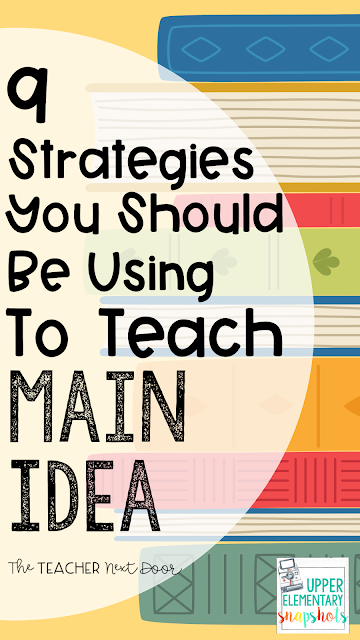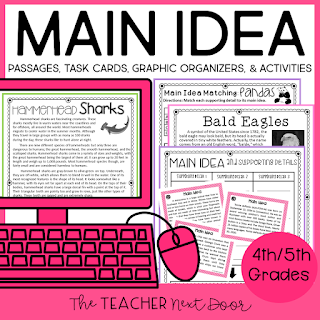Finding the main idea is one of the most challenging reading strategies to teach. On the surface, it doesn't seem that hard... I mean, we're just asking students to find what the passage is mostly about.
But when faced with the task, kids not only have to comprehend the passage, but they have to figure out which information is the most important, without getting sidetracked in the details.
Main idea is one of those concepts which needs to be revisited over and over. Even though upper grade students have been introduced to the main idea, they still need so much practice, especially as the text complexity is increased.
I've found that for the main idea (as with any difficult concept really) it's always good to use a variety of tools and activities in order to reach as many kids in our classrooms as possible. Here are some strategies which I've found to be effective.
1. Start with an Anchor Chart
I love using anchor charts in the classroom. Not only are they a great tool to refer to while teaching, but students are able to read them over and over while completing work independently.
2. Use Pictures
Pictures are a great first step to teach main idea. Without all of that sometimes cumbersome text to get through, students can still practice identifying the main idea concept by identifying what the picture is mostly about.
You can gather pictures for your students to display on the SmartBoard or to make quick task cards from National Geographic, Scholastic News, Weekly Reader, or from online sites that have free-to-use pictures, like Pixabay.
The bonus in using pictures is that kids can get repeated main idea practice, in the same time it might take to do one main idea identification with a passage. Of course, this is a baby step, and in the upper grades we wouldn't want to stop there, but it makes for a great introductory or remedial activity.
3. Emphasize Titles
Titles are often overlooked but are one of the first steps students should take when looking for the main idea. One activity you can do to practice using titles is to place a paragraph or very short passage on the SmartBoard (or overhead), but cover up everything except the title. Have students make predictions about what the paragraph will be about based on this title.
You could give them several options for a main idea based on the title and ask them which one is more likely, and why. For example, if the title was African Elephants, would the main idea most likely be how African and Asian elephants are different and alike, how African elephants cool themselves, or information about African elephants?
You can use the titles to help students think about supporting details and how these are smaller ideas but must match the main idea. For the African Elephant example, you might ask if they think that one of the supporting details might be where the elephants live in South America? Could it be about how an elephant uses its trunk? Would it possibly be about what an antelope eats?
These types of questions help kids see that if the title is telling you the topic of the passage, only certain types of information will be supporting details for that passage.
Once you've done some practice with titles, then it's time to read the passage and to find the main idea and supporting details.
4. Look at the First and Last Sentences
Besides titles, first and last sentences typically contain the main idea, but not always. Students should get in the practice of checking the first and last sentences with the title to see if they match. Many times, the main idea is openly stated in one or both of those sentences.In the upper grades, since we work on topic and conclusion sentences so much during paragraph writing, it makes sense to my students that most writers introduce a passage by telling the reader what it will be about or will conclude it by reminding them what the passage was mostly about.
5. Use Key Words
Keywords are a great tool to help find the main idea but, of course, it's a skill that must be taught. Keywords may be bolded and they provide clues to the main idea. Students can practice finding bolded keywords by doing a scavenger hunt with baskets of nonfiction books.Put students in pairs or in groups of threes and have them use sticky notes and to record any bolded keywords that they find. When they finish, they can meet with another group to share their findings or you could choose several to share out for the class. Make sure the kids give the book's title, as well as the bolded words so that they can combine this information to create a main idea statement.
Keywords may also be repeated in the same passage. The keywords may sometimes be exactly the same words over and over. For example, how many different words mean photosynthesis? Or the words more commonly will be repeated as synonyms. Here again, our work as writers can be incorporated into reading.
We've discussed the fact that good writers try not to repeat the same word over and over, or it becomes boring, tedious, dull, monotonous, and uninteresting (wink, wink...get the idea?). To find repeated keywords, kids need to be on the lookout for the same concepts over and over within the passage, even when the author uses synonyms to express these.
Headings and subheadings, which are types of titles, also help readers find the main idea. By combining the information from all three types of keywords, kids are more likely to be able to correctly identify the main idea.
6. Compare the Supporting Details to the Main Idea
Kids can often get sidetracked by a supporting detail and think that they've found the main idea when the fact was only one of the examples. I like to talk about the supporting details and the main idea as big and little ideas.A main idea is like the label on a moving box. Maybe the label on the box says Kitchen Items (main idea/topic) but inside you can find measuring cups, silverware, pots and pans, and so on. These would be the details. They all can fall under the label of kitchen items but could they all be called silverware (a supporting detail)?
One thing you can do to work on this idea is to look at paragraphs together. You can find great passages from classroom magazines like Scholastic or Weekly Reader or these could be ones that you select from other nonfiction texts.
Project the passage on to the Smart Board or make copies for your students. Ask students questions about the details, if they think one of these could be the main idea. If so, have them notice other supporting details. Would these other details also fall under that as a main idea?
They've got to come to the understanding that the main idea is fairly broad (not too broad though) and is big enough to connect to and to include ALL of the supporting details.
7. Use Examples and Non-Examples
By providing kids with a constant stream of main idea examples, they begin to understand what a main idea might look like. One activity I like to do is to look at a paragraph together and then show them the main idea and three supporting details listed in mixed-up order. This allows them to see the "size" of the sentences or what their scope is.Again, I always am asking, is this just a small detail or something that the whole paragraph/story is about? This is also a great way to scaffold their learning. It is much easier to determine the main idea when it is included in a set of four choices, rather than when students are asked to pull it out of their heads.
8. Prioritize Information
Here's where things get serious! Determining importance is huge when it comes to understanding the main idea. When students are able to practice this with you and with their classmates in small groups, this provides the reinforcement they need to master this skill.One great way to work on this is to read a paragraph and then to examine a set of four possible main ideas that you have created and posted on the Smart Board. To do this, I like to have my students write their answers on whiteboards (12 x 12 inch shower board cut down at Home Depot or Lowe's).
After we have read the paragraph together, they look at the four main idea choices and write either A, B, C, or D. The items selected as possible main ideas should be A. Too Broad (too big of an idea) or B. Too Narrow (this would be an interesting fact or detail) or C. Too Many Ideas (combining lots of supporting details), or D. Main Idea. This type of practice is training your kids to critically think about possible main ideas.
9. Add the Missing Title
For this activity, project a short paragraph without a title, on the SmartBoard. Remind students of the strategies we've been using, like first and last sentences, keywords, big ideas vs. small details, and so on. Using those clues, students create a title for the passage and when we do this as a whole class, I have them write these on their whiteboards.When everyone is done, we do a pair-share or I ask several to share with the whole class. Then I reveal the actual title. If their title was close and had the same idea, it was a success!
And... keep reviewing!
Just like all concepts we teach, the more we spiral student learning to reinforce it, the more likely it will be that students are able to truly master the concept. By revisiting it often, even asking a quick "What's the main idea?" as kids read a nonfiction passage, the concept becomes much easier for most students.
If you're looking for some easy to use, low or no-prep resources for main idea, these may be helpful to you.
I would love to hear some strategies that you've found to be helpful for teaching the main idea. Also, if you like the ideas here, please share them with a teacher friend!
For more ideas and strategies focused on upper elementary, be sure to sign up for The Teacher Next Door's free email newsletter! Bonus, you'll also gain access to my FREE Resource Library which contains exclusive upper elementary freebies that you won't find anywhere else!
Happy teaching,









